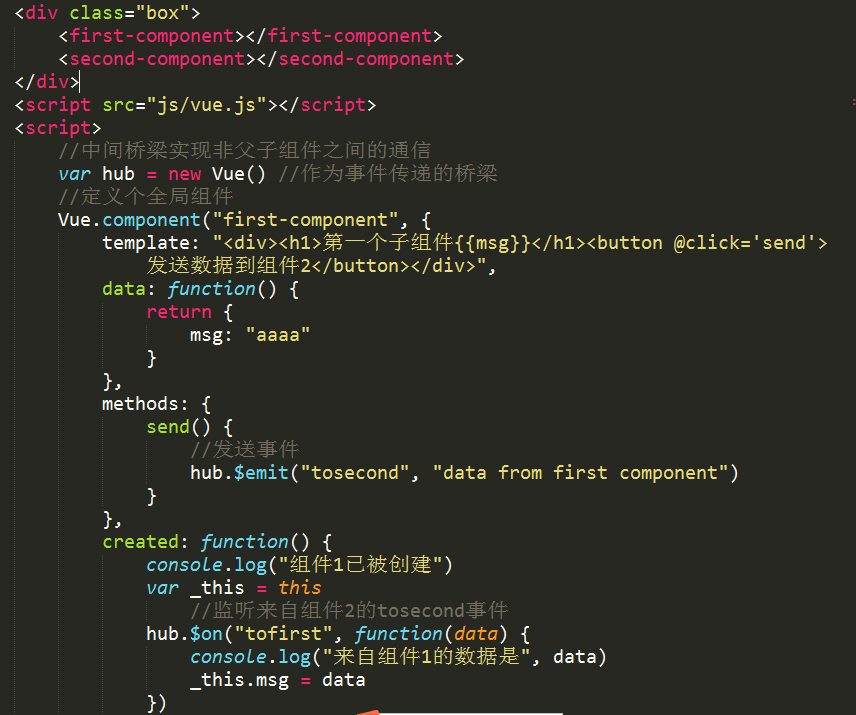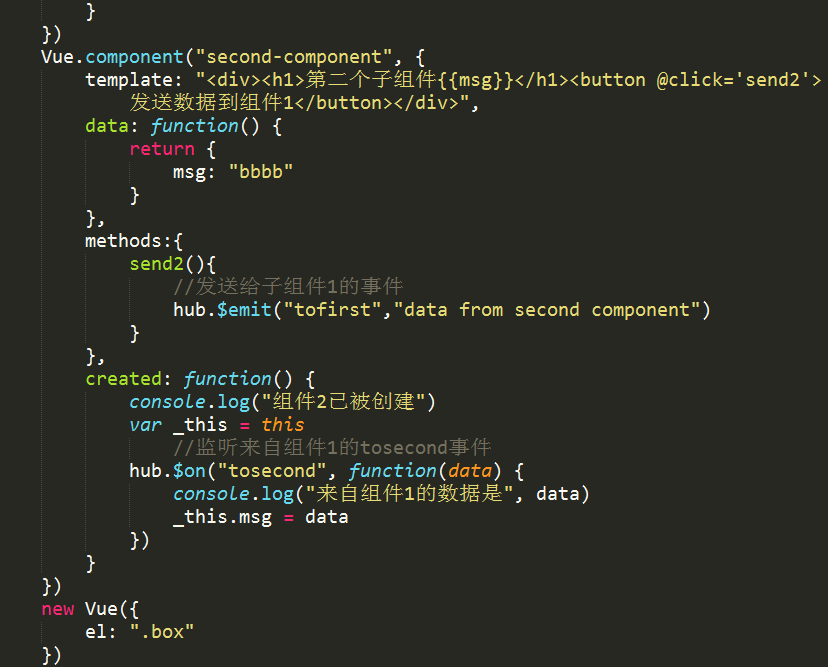一、组件
1、父组件传递数据到子组件
01、props第一种写法
Vue.component("my-component", {
props: ['msg'],
template: "<div><h1>child component,{{msg}}</h1></div>"
})
02、props第二种写法
Vue.component("my-component", {
props: {
msg:{
required:true/false //代表改变是否必须
type:String/Array/Number/Object //传入的变量的类型检查
},
names:{
required:false,
type:Array
}
},
template: "<div><h1>child component,{{msg}}</h1></div>"
})
2、子组件如何传递数据给父组件
01、是通过发送事件的方式实现
02、发送事件的过程
//使用组件
<div class="box">
<child-component @myevent="handle"></child-component>
</div>
<template id="child">
<div>
<h3>子组件标题</h3>
<button @click="send">发送</button>
</div>
</template>
//先注册组件再使用组件
Vue.component("child-component", {
template: "#child",
methods: {
send() {
//子组件向父组件传递数据的方式,是通过事件触发
this.$emit("myevent", "green")
//myevent---->子组件向父组件发送的事件名称
//green----->是发送的数据
}
}
})
//创建vue实例
new Vue({
el: ".box",
data: {
bgColor: 'red'
},
methods: {
handle(data) {
this.bgColor = data
}
}
})
3、非父子组件的通信
01、解决方案:通过中间桥梁实现非父子组件之间的通信
02、实现过程
//创建一个非父子组件之间通信的中间桥梁
var hub = new Vue()
//第一个组件
Vue.component("first-component",{
template:"<div><button @click='send'>发送事件</button><div>",
methods:{
send(){
//通过中间hub发送事件
hub.$emit("tosecond","some data....")
}
})
//第二个组件
Vue.component("first-component",{
template:"<div><button @click='send'>发送事件</button><div>",
created:function(){
//通过hub监听事件
hub.$on("tosecond",function(data){
//data---->hub发送事件是所携带的参数
})
}
})


4、组件的实际应用

-
style样式
*{ margin:0; padding:0; } body{ padding-top:50px; font-size:16px; } ul>li{ list-style-type:none; } .star{ margin:0 3px; color:red; } .star-empty{ margin:0 3px; color:#ccc; } label{ display:inline-block; 64px; text-align:right; } .title{ margin:5px 0; color:#666; font-size:20px; } .product-list{ overflow:hidden; } .list-item{ float:left; margin:10px; 200px; } .food-img{ display:inline-block; 100%; height: 150px; } -
html样式
<div class="container"> <div class="product-list"> <div class="list-item" v-for="item in products"> <img class="food-img" :src="item.img" alt=""> <p class="title">{{item.title}}</p> <Star :stars="item.stars"></Star> </div> </div> </div> <template id="star"> <ul> <li v-for="(title,index) in titles"> <label>{{title}}</label> </li> </ul> </template> <template id="star"> <ul> <li v-for="(title,index) in titles"> <label>{{title}}</label> <span v-for="item in new Array(stars[index])" class="star glyphicon glyphicon-star"></span> <span v-for="item in new Array(5-stars[index])" class="star-empty glyphicon glyphicon-star-empty"></span> </li> </ul> </template> -
script样式
//定义一个评分的组件 Vue.component("Star",{ template:"#star", data:function(){ return { titles:["总 评","推 荐","口味包装"] } }, props:{ stars:{ required:true, type:Array } }, created:function(){ console.log(this.stars) } }) new Vue({ el: ".container", data:{ products:[{ img: "img/01.jpg", title: "商品1", stars: [2, 2, 5] }, { img: "img/02.jpg", title: "商品2", stars: [3, 4, 4] }, { img: "img/03.jpg", title: "商品3", stars: [3, 3, 3] }, { img: "img/04.jpg", title: "商品4", stars: [2, 1, 4] }] } })